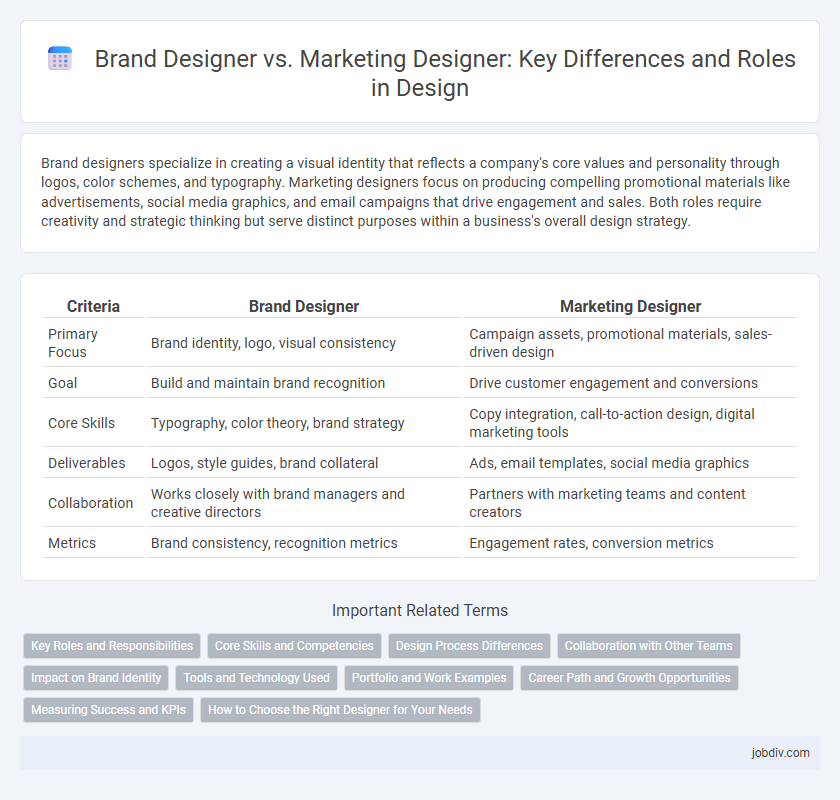Brand designers specialize in creating a visual identity that reflects a company's core values and personality through logos, color schemes, and typography. Marketing designers focus on producing compelling promotional materials like advertisements, social media graphics, and email campaigns that drive engagement and sales. Both roles require creativity and strategic thinking but serve distinct purposes within a business's overall design strategy.
Table of Comparison
| Criteria | Brand Designer | Marketing Designer |
|---|---|---|
| Primary Focus | Brand identity, logo, visual consistency | Campaign assets, promotional materials, sales-driven design |
| Goal | Build and maintain brand recognition | Drive customer engagement and conversions |
| Core Skills | Typography, color theory, brand strategy | Copy integration, call-to-action design, digital marketing tools |
| Deliverables | Logos, style guides, brand collateral | Ads, email templates, social media graphics |
| Collaboration | Works closely with brand managers and creative directors | Partners with marketing teams and content creators |
| Metrics | Brand consistency, recognition metrics | Engagement rates, conversion metrics |
Key Roles and Responsibilities
Brand designers focus on creating a cohesive visual identity that reflects a company's core values through logos, color schemes, and typography. Marketing designers develop targeted campaign visuals and digital assets aimed at driving customer engagement and conversions. Both roles require a strong understanding of design principles, but brand designers emphasize long-term brand consistency, while marketing designers prioritize immediate market impact.
Core Skills and Competencies
Brand designers excel in visual identity creation, mastering logo design, color theory, and typography to establish a consistent and memorable brand image. Marketing designers focus on creating persuasive graphics for campaigns, utilizing skills in layout design, audience targeting, and digital advertising platforms to drive engagement and conversions. Both roles require proficiency in design software like Adobe Creative Suite, but brand designers emphasize strategic brand positioning while marketing designers prioritize ROI and campaign effectiveness.
Design Process Differences
Brand designers focus on creating a cohesive visual identity through logo development, color schemes, and typography that reflect the brand's core values and personality. Marketing designers prioritize designing promotional materials such as advertisements, social media graphics, and email templates that drive conversions and engage target audiences. The design process for brand designers involves extensive research into brand positioning and long-term consistency, while marketing designers emphasize iterative testing and optimization to maximize campaign performance.
Collaboration with Other Teams
Brand designers collaborate closely with marketing, product, and UX teams to ensure consistent visual identity across all customer touchpoints. Marketing designers work alongside sales, analytics, and content teams to create targeted campaigns that drive engagement and conversions. Both roles require seamless communication and alignment to achieve cohesive brand messaging and effective marketing strategies.
Impact on Brand Identity
Brand designers establish the core visual language and personality of a brand through logo creation, typography, and color schemes, ensuring consistent recognition across all touchpoints. Marketing designers adapt this established identity to create campaign-specific materials that drive customer engagement and conversion rates. The synergy between brand designers and marketing designers enhances brand equity by maintaining a cohesive image while optimizing promotional effectiveness.
Tools and Technology Used
Brand Designers primarily utilize tools like Adobe Illustrator, Photoshop, and Sketch for creating logos, typography, and visual identities that establish brand consistency. Marketing Designers leverage software such as Adobe InDesign, Canva, and social media content creation platforms to produce engaging marketing materials and campaign visuals. Both roles increasingly integrate prototyping tools like Figma and collaboration platforms like Slack to streamline workflow and ensure cohesive design execution.
Portfolio and Work Examples
Brand Designers focus on creating visual identities that communicate a company's core values through logos, typography, and color palettes, emphasizing consistency across all brand touchpoints. Marketing Designers produce campaign-specific visuals such as ads, social media graphics, and promotional materials that drive engagement and conversions. Portfolios of Brand Designers showcase cohesive brand systems and style guides, while Marketing Designers highlight diverse marketing collateral and performance-driven design projects.
Career Path and Growth Opportunities
Brand Designers specialize in creating visual identities that communicate a company's core values and personality, often progressing into roles like Creative Director or Brand Strategist. Marketing Designers focus on producing promotional materials tailored to campaign goals, with career growth leading towards Marketing Manager or Digital Campaign Specialist positions. Both paths offer opportunities for specialization and leadership, but Brand Designers tend to develop strategic brand positioning skills, while Marketing Designers refine data-driven, conversion-focused design expertise.
Measuring Success and KPIs
Brand Designers measure success through brand recognition, audience engagement, and consistency in visual identity, using KPIs like brand recall, logo usage accuracy, and emotional response metrics. Marketing Designers focus on conversion rates, click-through rates, and campaign ROI to evaluate effectiveness, emphasizing performance-oriented KPIs tied to specific marketing goals. Both roles rely on data-driven insights but apply distinct criteria aligned with branding strength versus immediate marketing impact.
How to Choose the Right Designer for Your Needs
Choosing the right designer involves understanding that a Brand Designer specializes in creating a cohesive visual identity that reflects your company's core values, including logo design, color schemes, and typography. In contrast, a Marketing Designer focuses on crafting engaging promotional materials like advertisements, social media graphics, and email campaigns to drive sales and conversions. Assess your project goals--whether you need to build brand recognition or boost marketing efforts--to determine if a Brand Designer or Marketing Designer best aligns with your business objectives.
Brand Designer vs Marketing Designer Infographic

 jobdiv.com
jobdiv.com